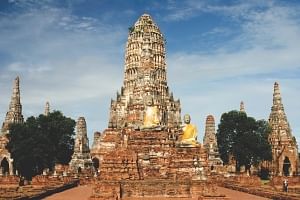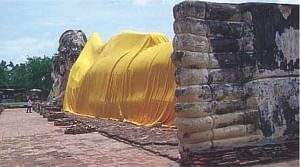| Home - Back Issues - The Team - Contact Us |
 |
| Volume 10 |Issue 28 | July 22, 2011 | |
|
|
History The Invincible City, Once David Wilson Hilariously, the name Ayutthaya (ah-you-tah-ya) means “invincible”. The meaning makes no sense to the modern visitor because the ancient Thai capital occupying an island where three rivers meet is a classic vanquished city, an urban Titanic. You can see why the ancient Thais felt bullish about Ayutthaya, however. Founded in 1350, the city at the junction of the Chao Phraya, Lopburi and Pasak rivers evolved over time into Thailand's temple-peppered spiritual heartland. Ayutthaya was also the richest and most important city in Southeast Asia, bolstered by an unbroken line of 30-plus kings, who together clocked up four centuries.
Their empire, which represented the peak of Thai power and fuelled national pride, covered a huge area: northern Thailand (including the Million Elephants kingdom now called Laos), plus most of Cambodia and part of Burma and Malaysia. European visitors, among them ambassadors of France's King Louis XIV were stunned. Ayutthaya made their native cities look like villages. Even everyday “Ayutthayans” lived well – much better than European peasants. The success of the old city with one million residents stemmed from trade. The thriving seaport lured merchants from around the globe, on the hunt for salt, elephants and pearls, among other commodities. But Ayutthaya's globalised rise stoked envy and greed. In 1767, roughly the time that Americans were tossing tea into Boston harbour, after repeated attacks and a siege, the old enemy, Burma, finally breached its borders. Torching temples and trashing monasteries, Burmese shock-troops decapitated Buddha statues, then took the heavy heads back to the motherland as trophies. Clearly, just like the henchmen of Burma's latter-day junta, the invaders lacked refinement. Still, the fractured landscape that the looters left – loosely called the “historical park” – exerts spooky charm at dawn and dusk, the best time to explore. Do too much during the day, and you may flake from the heat. My journey to Ayutthaya from the original Thai capital it ousted, Sukhothai, took a hellish six-and-a-half hours. At the mid-point – the lower northern city of Phitsanulok – the bus bumbled around for 60 minutes, crawling from one downtown bus station to another. Do not follow my path. The way to get to the island city is from Bangkok. The journey by bus or train takes only 90 minutes. If you fancy taking the cool and comfortable day-long scenic route, you can catch a ferry that plies the sleepy Chao Phraya. However you go, Ayutthaya, which is lined with feel-good riverside restaurants, makes a refreshingly mellow break from Bangkok. You can tour the town in a tuk-tuk cab for under 500 baht or just amble around the elegantly wrecked Mahatat temple, which stands near Farang (foreigner) Street, not far from what exists of the centre. Doubt surrounds exactly when Wat Mahatat, the city's signature temple, came to be. Some time during the 14th century, it seems. In about 1625, according to sacred-destinations.com, the top of the temple's prang (spire) snapped off, and was rebuilt in 1633 some 4m higher, only to topple again, putting it in good company with the headless Buddhas. Fast-forward several centuries to 1956, when researchers unearthed a secret Wat Mahatat chamber. Among the treasures that the chamber contained were gold jewellery and a gold casket containing a Buddha relic. Now bereft of Siamese bling, Wat Mahathat is a classic shambling Ayutthaya ruin. Think crumbling stupa (stone spires) ringed by low, clay-like “laterite” walls and signature rows of headless Buddhas. Famously, one cut-off Buddha bonce is embedded in the snaking roots of a tree. Few sights in Thailand – or Southeast Asia, even – are more striking than the disembodied “bodhi Buddha” that must have been photographed more than any Thai pop prince or diva. Nobody knows how the head became entwined in the roots. According to one story, the tree just grew around it during a phase when the temple went feral, lapsing into jungle. According to another, juicier story, after a temple section collapsed, a thief carried it to the spot where it sits, then ran out of steam. Either way, the bodhi Buddha head serves as a hypnotic focal point. Tear yourself away from its grey gaze, and you may stroll across the heron-haunted, pond-peppered parkland that unfolds from Wat Mahathat's fringes. The park is vast, like everything to do with Ayutthaya. Civic buildings, including the tourist board offices, are just as grand as the three downtown palaces. Ayutthaya's most magnificent sight must be Wat Lokayasutha's (Temple of the Earth) reclining Buddha which is tucked away near another noted temple, Wat Worapoh. Built from bricks and cement, the cape-draped giant the length of a cruise ship actually has a head, which rests on a lotus. There's a smile playing on his lips – an apparent sign that he has reached nirvana (Buddhist heaven). What a classy contrast he cuts with the cartoon-style human statues that grace another Ayutthaya highlight, the floating market. Well removed from Ayutthaya's centre, the market is worth a wander if you have a weakness for scented soap and other boutique knick-knacks in a Venice-style setting. For deeper immersion, you can do the cruise which is touted as 20 minutes but feels like 10. For high adventure, take a howdah ride on one of the elephants based in the shadowy stables over the road from the market. Perching atop one of the black, russet-splotched mobile hulks may look like a blast, but you may have reservations. The reason: when nobody is riding the elephants, the mahout handlers keep them in line with bullhook blows. True, the treatment could be seen as tough love. After all, the elephants are dinosaur-sized. If, jolted by the bang of a firecracker, say, one ran amok among the stalls and statues, it would wreak havoc. Still, the bullhook blows are unnervingly loud – thunderous cracks. So you might feel more comfortable exploring the elephant kraal: a massive brick pen surrounding an inner-wall made of teak pillars hammered into the ground. The kraal – Thailand's last – dates back to the 16th century when cowboys astride tame elephants captured wild ones from herds. How the cowboys, who wielded bamboo poles with leather nooses, avoided being yanked from their seats by the beasts is a puzzle. The urge to stay mounted must have been strong because an elephant was enormously valuable: a cutting-edge war machine, heavy-transport vehicle and “product” for export to India and Persia. At the heart of the kraal, once used by the Siam army, stands a pavilion housing the image of the Hindu elephant god, Ganesh, whose faith is upstaged by more than just Buddhism. In a throwback to the days of trading with Persia, Islam permeates Ayutthaya. Islam plays out palpably in mosques and wailing muezzins whose echoing calls roll along the canals. The streets – in particular the vital artery Uthong Road – smell sweet, thanks to Muslim caterers cooking Islamic-influenced dessert, roti sai mai: candy floss wrapped in roti flatbread. Take your pick from green, pink and beige varieties. Wildly-coloured buses emblazoned with eagles barrel past the roti stalls in a sign that the city with a modest 60,000 population is growing commercialised. Soon, Ayutthaya may start to feel like a Bangkok suburb. Already, it is a magnet for time-crunched upmarket “mall Thais” in search of Siam. Still, for now the farang masses head for the beaches. The overwhelming sensation at the thinly touristed town is of space, sap and wildlife. Glance at the sky, and, often, you see a heron lazily sailing overhead. Lucky creature. What a buzz it would be to have its view of the canal-laced, heritage-listed giant ruin once daftly deemed invincible.
Copyright (R) thedailystar.net 2011 |

